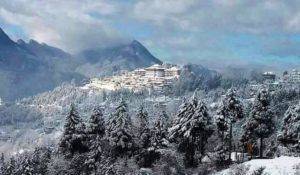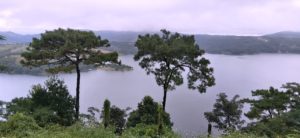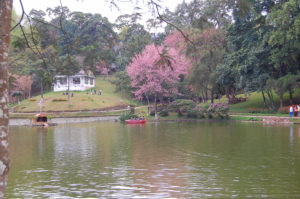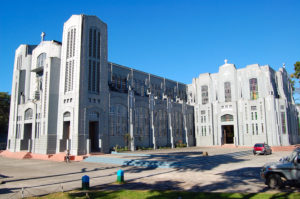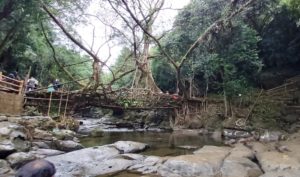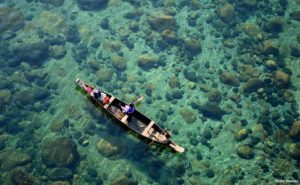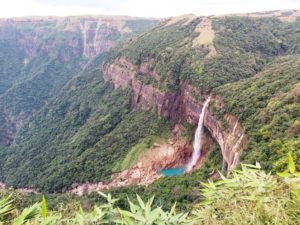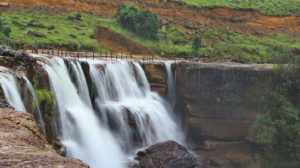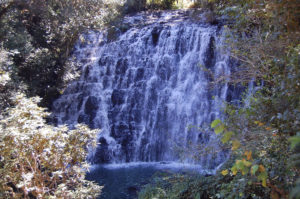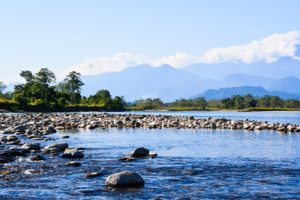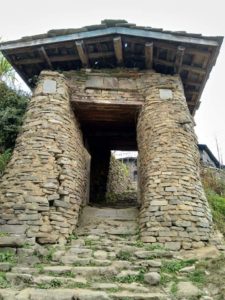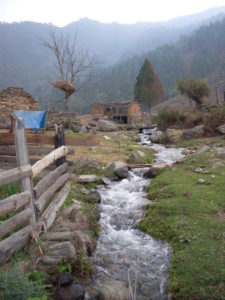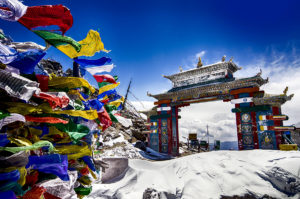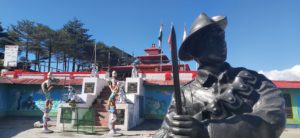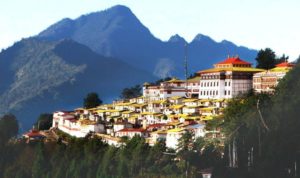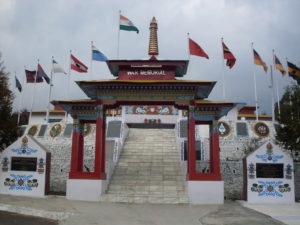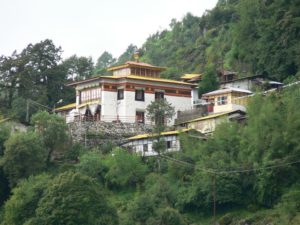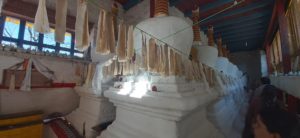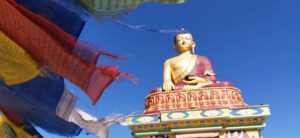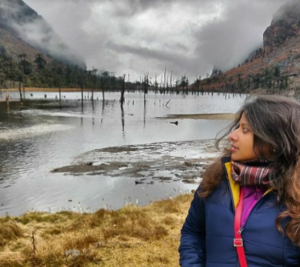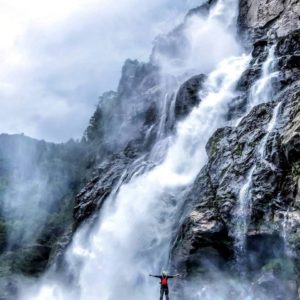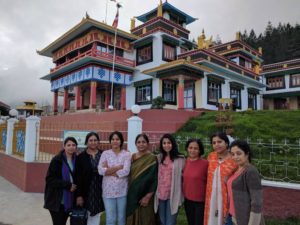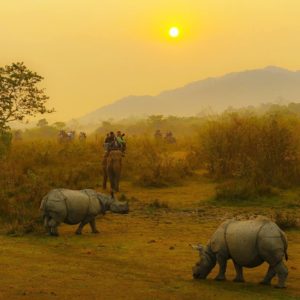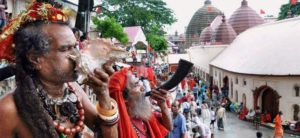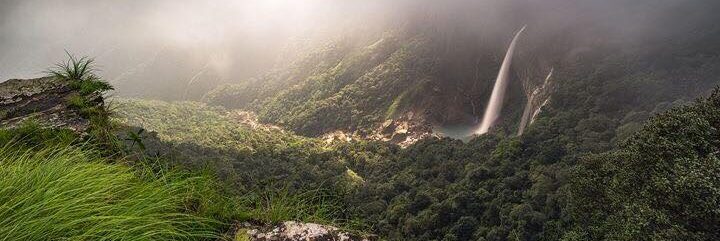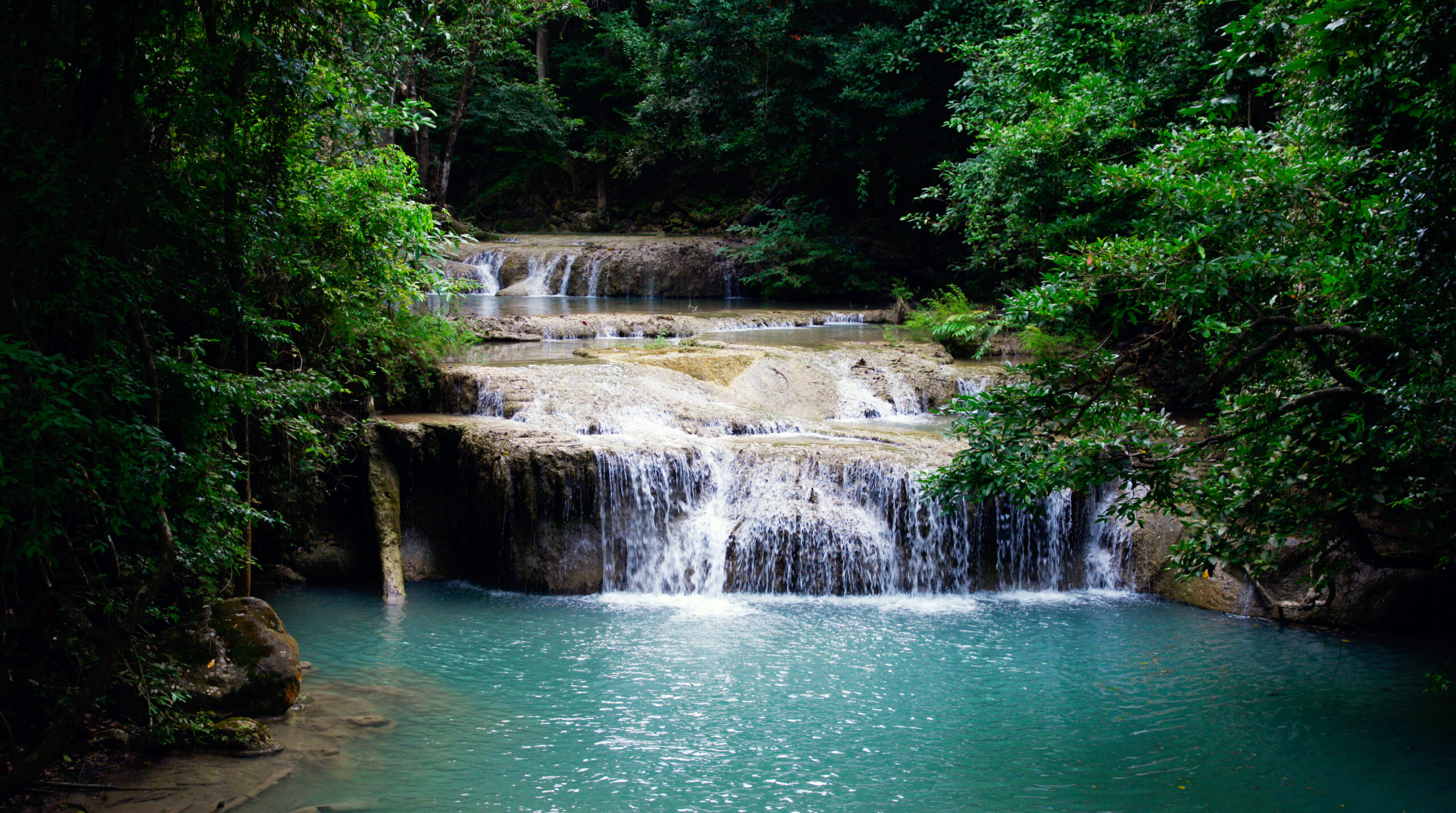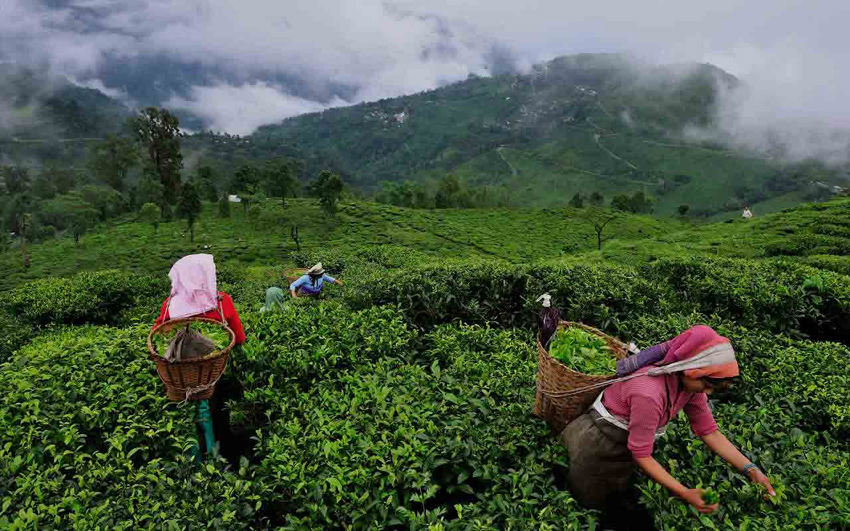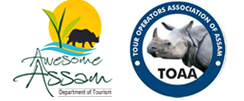Tour Highlight
- Waterfalls in Cherrapunjee
The Tour Package Offers The Visit To The Beautiful Hill Stations Like Shillong & Cherrapunjee And Enjoy The Spectacular Waterfalls Along With The Chances To Play With The Clouds
- Tawang Monastery at winter
The Visit To The Tawang Monastery And The Snow-Capped Himalayan Ranges Of Arunachal Pradesh Will Give You The Chance To Feel The True Essence Of Peace And Karma.
- One Horned Rhino in Kaziranga National Park
A Couple Of Nights At Kaziranga National Park Will Give You The Chance To Experience The True Wilderness. The Safari On The Elephant’s Back Coupled With A Jeep Safari Will Surely Surge Your Adrenals.
Itineraries
Day 01: Guwahati / Shillong (95 Kms, 3 ½ hrs drive)
Arrive Guwahati by flight.
Meeting upon arrival and depart for Shillong, the Scottland of East.
En route visit
- Umiam Lake Shillong
Barapani (Umiam Lake): As per the legends, two heavenly sisters decided to make their way to Meghalaya. However, one of them had reached the destination and the other could not due to some reason. So the former could not traced out her sister and started crying with her broken heart. She cried so much that and a lake was formed with her tears. Locally known as Umiam Lake, Barapani means vast waters.
Today it becomes a hub for the water sports activities such as speed boats, sailboats and water scooters. Adjoining to the lake, the Nehru Park offers an aviary and a collection of orchids and butterflies.
Arrive Shillong and check in at hotel.
Shillong: The Capital of Meghalaya, Shillong is one of the major tourist destinations in North East India. The British loved this place so much that they had established its Capital for Eastern Bengal and Assam For its climate and unique topographical features the British referred Shillong as the “Scottland Of The East”.
Later visit:
- Wards Lake
Wards Lake: Wards Lake is located in the heart of the Shillong City adjoining to the Governor’s Residence. Shaped like a horseshoe, it is one of the prominent hang-out spot in Shillong. This century old lake was built by an engineer named Mr. Pollock. Hence it is also known to be as “Polok’s Lake”. One can opt for boating and pleasant walks on the cobbled sand stone pathways covered with varieties of flowers. The lake also has an arched bridge from where one can feed the fish.
- Shillong Cathedral
Cathedral of Mary Help of Christian: Situated in At Laitumkhrah, it is the largest Cathedrel in Meghalaya attracts thousands of devotees. The colorful glasses of the skylight window along with the paintings of the Jesus spreading the messages of God are influenced by the European art and architecture.
Rest of the time free at leisure.
Overnight at hotel.
Day 02: Shillong / Mawlynnong / Dawki / Shillong
Morning after breakfast depart for a whole day excursion to Mawlynnong:
Mawlynnong Village has earned the distinction of being the cleanest village in India. It is situated 90 kms. from Shillong and besides the picturesque village, offers many interesting sights such as the living root bridge and another strange natural phenomenon of a boulder balancing on another rock.
Mawlynnong nestled in the pristine hill state of Meghalaya, is along the Indo-Bangla border. This cute and colourful little village is known for its cleanliness. The main occupation of the villagers is agriculture. They mostly grow betel nut. About 82 households live in Mawlynnong. Keeping the surrounding environment clean is an age old tradition. Discover India magazine declared the village as the cleanest in Asia in 2003.
- Living Root Bridge in Mawlynnong
A dustbin made out of bamboo is found all along the village. Every one makes it a point that dirt and waste are not thrown everywhere. All the waste from the dustbin is collected and kept in a pit, which the villagers use as manure. The villagers are now on a mission to ban plastic. The village with cent per cent literacy is conscious and they are spreading the message of conservation and protection of the forest. Locals plant trees to ensure that the virgin forest is kept intact and also replenished.
Mawlynnong’s fame is now drawing an endless stream of guests from across the country and abroad. Although residential facilities are still scarce and are in the process of being developed, the existing one constructed from bamboo and thatch is quite hospitable and restful. Mawlynnong is an artist’s delight and the sort of getaway that would titillate creative writers and poets.
- Boating in Dawki on Umkot river
Dawki: A day’s excursion from Mawlynnong, Dawki lies but 2 Kms from Bangladesh. Despite the fact that the area is located in a place that has been for years demanding development, one is amazed by the quality of the roads, and the road to Dawki perhaps epitomizes the idyllic hill drive. The black metalled road, offset by the rich, wet green and dark red-brown patches offered a smooth contrast that technology can scarcely capture. The cool, wet air brushes over your face and refreshes and revitalizes you as it enters your body. Dawki is a small village and its main attraction is the Umngot River that marks the natural separation between the Khasi and the Jaintia Hills.
The river can be forded by a suspension bridge that connects India to Bangladesh and facilitates trade between the two nations. The Umngot is the site for a boat race that is held in March-April, but even otherwise, seeing this large emerald-green serpent threading its way through the hills, with fishermen’s boats dotting its surface, right into the plains of Bangladesh, is a sight whose majesty echoes long after you leave it.
Later return to Shillong.
Overnight at hotel.
Day 03: Shillong / Cherrapunjee / Shillong (56 Kms 1 way, 1 ½ hrs drive)
Morning after breakfast depart for Cherrapunjee.
Cherrapunjee is a small hamlet, situated at an altitude of about 4823 feet (1484 m). Locally known as ‘SOHRA’. Cherrapunjee is located in the southern most point of Khasi hill sharing the border of Sylhet district of Bangladesh. Cherrapunji offers a panoramic view of the hilly terrains, deep gorges and valleys with its spectacular waterfalls. It was once having the record of being the wettest place on earth, with an average rainfall of about 1150ms. However, this record has been overtaken by a nearby place Mawsynram
In Cherrapunjee visit:
- Nohkalikai Waterfalls
Nohkalikai falls: This waterfall located 4 kms away from Cherrapunjee and is possibly between 1500 and 2000 feet tall. Known to be the fourth longest fall in the world it carries a pathetic legend behind its name. A woman named Ka Likai had a illegitimate child. After marriage the husband became jealous of her love for her daughter. One day Ka Likai was out for work and her husband killed the daughter, cooked her flesh into a meal. When the woman enquired about her daughter, her husband showed the sign of ignorance. Before she went to look for her daughter, she thought of eating something and had the meal that her husband prepared for her. After having the meal she found both the wrist of her daughter in the betel-nut basket. Then she realized what had happened, killed her husband with a dagger and threw herself off this cliff of this falls. This is how the falls got its name which means “Fall of Ka Likai.”
- Mawsmai Cave
Mawsmai Cave: This 250m long cave is the major attraction for the tourists in Cherrapunjee. This cave is located 6 kms away from Cherrapunjee near to Mawsmai village. This natural limestone cave is wide enough for a person to walk comfortably, and one can see the myriads of stalagmites and stalactites all over the caves which are growing gradually. The caves are dark inside and electric torches are installed for the convenient of the tourists.
Thangkharang Park: Thangkharang Park is situated 12 km from Cherrapunjee. The park is the house of various orchids and birds. One can see the 180 degree view of the plains of Bangladesh on a clear day.
- Seven Sisters Waterfalls
Nohsngithiang Falls (Seven Sister Falls): It is a seven-segmented waterfall, which plunges over the top of limestone cliffs of the Khasi Hills. The falls only flow during the rainy season. In full spate, the segments stretch most of the way along the cliff. The water falls from a height of 315 metres (1,033 ft) and has an average width of 70 metres (230 ft).The waterfalls get illuminated by the sun from dawn to sunset. The vibrant colours of the setting sun on the waterfalls make it beautiful to behold
- Dainthlen Waterfalls Cherrapunjee
Dainthlen waterfall: Dainthlen waterfall, located at a distance of 5 km from Cherrapunjee, is one of the most popular waterfalls. This waterfall has a legend attached to it, according to which it is said that people killed a huge snake living in the cave here to get rid of his terror. Tourists visiting the waterfall can explore the natural rock carvings of the snake, which represent the symbol of evil, greed and corruption.
Later return to Shillong.
In Shillong visit:
- Shillong Peak
Shillong Peak (Foreign Nationals are not allowed): It is the highest point of Shillong, located in the upper Shillong an an altitude of 1961 meters (6,433 feet). The name Shillong originated from “Leishyllong” meaning god who is believed to live on the Shillong peak, overlooking the city. It is located 5 kilometers away from Shillong and on a clear day one can enjoy the beautiful view of the entire city.
- Elephant Falls
Elephant Falls: Located in the Upper Shillong 10 kms away from the Shillong town it is one of the majestic waterfalls in Meghalaya. The water of this three steps falls comes down in flows from different levels over the fern-covered rocks and falls into the canyon down below. In the morning it forms a wonderful sight when the sun rays fall on the cascades of water creating the rainbow colors. The best time to visit the waterfalls is during the monsoon when it offers a breath-taking scenery. The forests covered with ferns and thick bamboo grooves are also worth visited for the nature lovers to find the presence of various species of butterflies, birds and orchids.
Overnight at hotel.
Day 04: Shillong / Nameri National Park (285 kms, 7 hrs drive)
Morning after an early breakfast visit:
Shillong Golf Course: Shillong Golf Course is termed as the “Glen-eagle of the East” at the United States Golf Association Museum. The Golf Course is situated in a valley covered with thick groves of pine and rhododendron trees at an altitude of 5200 ft. Previously it was a nine hole course and later converted into a eighteen hole course in 1924 by Captain Jackson and C. K. Rhodes. It is the third oldest Golf Course in India.
Don Bosco Museum: The Don Bosco Museum of Indigenous Cultures at DBCIC (Don Bosco Centre for Indigenous Cultures) is Asia’s largest Museum of Indigenous Cultures of its kind. In it the visitor can have an overview of the whole of North East India. Rising into Shillong’s skyline the Museum is a seven storey building with 17 well laid out Galleries of international standard containing artefacts, paintings, fibreglass figures – all a feast to the eyes and a source of knowledge. The topmost Gallery is where the visitors can relax and enjoy some of the rare dances of the North East. The Museum is indeed a surprise to visitors both from India and from abroad. Its best publicity are the visitors themselves who come to see it.
Later depart for Nameri National Park
- Jia Bharali river at Nameri
Nameri National Park: The Nameri National Park of 200 sq kms area is located in the Sonitpur district, bordering Arunachal Pradesh and it is also the core area of Nameri Tiger Reserve (344sq kms). It is the home of Mammals like Elephant, Tiger, leopard, Sambar,Barking deer, Hog Deer, Wild Boar,Gaur, slow loris,gaplangur,Burmese ferret badger, and over 350 species of birds including White-winged Wood Duck, Ibisbill (uncommon), Ruddy Kingfisher, Palla’sfishing eagle,Lesser Adjutant stork , Greater spotted eagle,Rufous necked hornbill, Great pied Indian hornbill, Wreathed hornbill, Long-billed Ringed Plover, Sultan Tit, and Yellow-bellied and White-throated Fantails. Another important wild life sanctuary of Arunachal Pradesh The Pakhui (Pakke) wild life Sanctuary adjoins the Park on its North-Eastern point. The river Jia- Bhoroli and its tributaries namely the Diji, Dinai, Doigurung, Nameri, Dikorai, Kharietc crisscross the park. During rainy season A few jheels (during the rainy seasons) also dot the area. One can enjoy rafting in the Jia Bhoroli river in the south western boundary.
Arrive and check in at Eco Camp.
Rest of the time free at leisure
Overnight at hotel.
Day 05: Nameri / Dirang (145 Kms, 7 hrs drive)
Early morning go for the nature walk and the bird watching trip into the dense jungle of Nameri National Park with the forest guards.
After an early breakfast departs for Dirang by the same vehicle.
Arrive Dirang and check in at hotel.
Dirang: Dirang 40 kms from Bomdila is situated at an altitude of 1497 meters. It is an ideal hill resort in West Kameng district with beautiful Apple Nursery, Kiwi Farm, Yak Research Centre, Buddhist Gompa, Hot Water Spring and ancient Dirang Jong (Fort). It is the base camp for trekking to Gorichen peak and other bird watching trails
Afternoon visit:
- Dirang Dzong
Dirang Dzong: Dirang Dzong fort is a representation of the culture of the Monpa Tribes. This fort, built in 1831 AD served as a centre of all the administrative activities of the Monpas during those times. The Fort is set a top on a hill top consisting of a four storied stone building. A wooden gate designed in local architectural pattern adds to the splendid uniqueness of the fort.
- Dirang Monastery
Thupsung Dhargye Ling: Thupsung Dhargye Ling is a temple and learning institute for the study of Tibetan Buddhism by laypeople and monks, located in the Himalayan village of Dirang, India. The name, Thupsung Dhargye Ling was given by His Holiness, the Dalai Lama and means: “Place of Flourishing of the Buddha’s Speech”.
Overnight at hotel.
Day 06: Dirang / Tawang (140 Kms, 6 hrs drive)
Morning after breakfast visit:
- Sangti Valley
Sangti Valley: At a distance of 12 Kms. beyond Dirang is the famed Sangti Valley, Sangti is dotted with numerous picturesque spots, which are ideal for holidaymakers. One of the prime attractions is a sheep breeding farm. The other one being the Chuskar (traditional water mill), a flour mill system using hydro power, which is used by the villagers to grind the millets. The Sangti valley is the favored tourist destination for avid bird watchers as well as it is home to the endangered back necked cranes during winter months which come to nest here from Tibet.
Later depart by car for Tawang.
En route visit
- Welcome Gate At Sela Pass
Sella Pass: The entry point into the Tawang Valley is Sela pass at an elevation of 13700 ft above the sea level.. Legend says that a monpa woman supported sepoy Jashwant Singh during his battle with the Chinese. She brought sepoy Jashwant supplies and used to heal his wounds. When Jashwant got martyrdom she killed herself as an act of loyalty.
The glimpse of Paradise Lake in the Sella Pass makes your visit worth. Most of the time the lake is covered with thick blanket of snow.
- Jaswant Garh War Memorial
Jaswant Garh: The war memorial is located 14 kms from Sella Pass on the way to Tawang. The memorial pay homage to Jaswant Singh Rawat, Mahavir Chakra Awardee posthumous (the second highest award from the Indian Army). In the famous battle of Nuranang against Chinese in November 1962, Rawat and two other soldiers from 4th Batallion Garhwal Rifles were instrumental in killing 300 Chinese soldiers in 72 hours.
Arrive Tawang and check in at hotel.
Evening free at leisure.
Overnight at hotel.
Day 07: Tawang
Morning after breakfast explore Tawang, visiting
- Tawang Monastery
Tawang Monastery (Vihar): Tawang Monastery about 400 years old, situated at an altitude of approximately 10,000 ft. is the second largest Buddhist monastery in India. It also holds the distinction of being the birthplace of the 6th Dalai Lama. The monastery is the house of more than 700 monks. The monastery was founded by Merag Lama Lodre Gyamtso, in 1681 in accordance to the wishes of the 5th Dalai Lama, Nagwang Lobsang Gyatso. As per the legend, the site of the Monastery was chosen by the horse of Merag Lama. Merag Lama, who had been unable to decide a site to establish the monastery. One day he was praying in cave, seeking a divine guidance. When he came out after the prayers, he found his horse was missing. On search, the horse was located standing quietly on a hilltop. Considering that as the sign of divine blessing he decided to construct the monastery at the very spot. The monastery is also called Galden Namgey Lhatse meaning celestial paradise. There is a magnificent 8 meter high statue of Lord Buddha. The ancient library inside the courtyard has an excellent collection of thangkas, painted with the blood from the nose of 5th Dalai Lama and valuable Buddhist manuscripts mainly Kanjur and Tanjur numbering 850 bundles.
- Tawang War Memorial
Tawang War Memorial: The memorial is dedicated to the martyrs of the 1962 Sino-Indian war. The memorial is 40-foot-high and like a stupa in design. It is locally called ‘Namgyal Chortan’. The names of 2420 martyrs imprinted in gold on 32 black granite plagues.
The Craft Center: The craft center in Tawang sells beautiful masks, hand woven carpets, jewellery in silver, coral and amber, ‘chubas’ the local dressand delightful affordable mementos.
- Gyangong Ani Gompa Tawang
Gyangong Ani Gompa: Ani Gompas, which literally translates into ‘Nunnery’, are run by the women monks.No male monk can be seen near these Ani Gompas and all you can see are sparkle eyed and clean-shaven nuns who are busy managing the day-to-day operations of
the Ani Gompa. Gyangong Ani Gompa is the oldest Ani Gompa in the Tawang District. It is situated in the lap of a far off mountain laced with natural scenery. This Ani Gompa is under the administration of Tawang Monastery.
- Stupas inside the Urgelling Monastery
Urqelling Monastery: It is the birthplace of the 6th Dalai Lama who is the only Indian to have risen to such a high position in Gelupka Sect of Buddhism so far. Inside the monastery there are several Stupas (Vihar) and people from all walks of life visit this place during Buddhist new year to get the blessing for the coming year.
- The Giant Buddha Statue Tawang
The Giant Buddha Statue: If you are in tawang, this newly built Giant Buddha Statue is the must visit place. The location of the statue is such that it can be seen from most areas in Tawang. The life of Buddha is depicted on the walls inside the prayer room underneath the statue. This statue was consecrated by Padma Shree Awardee H.E. Thegtse Rinpoche on 20th June 2016. The statue is truly an excellent piece of work of and worth spending an hour or so.
- Sangestser Lake or Madhuri Lake awang
Sangestser Lake & Bum La Pass (OPTIONAL: Rs. 5500 Per Vehicle / Foreign Nationals are not allowed): Popularly known as Madhuri Lake is located 35 kms away from Tawang near the China Border. The drive to Sangestser Lake is full of thrill and one can still see the war bankers that had been used during the Chinses aggression in 1962 and the beautiful PTSO lake.
Later visit the Indo-Chinese border point at Bum La
Overnight at hotel.
Day 08: Tawang / Bomdila (180 Kms, 7 hrs drive)
Morning after breakfast depart for Bomdila
En route stop at the Nuranang falls.
- Jung Falls Nuranang
Nuranang Falls: Nuranang Falls, Also Known As Jung Or Jang Falls Is A Splendid And Stunning Waterfalls Around Tawang. The Nuranang River Originates From The Sela Pass And Before Meeting Tawang River It Forms Into This Beautiful Waterfall. A Short Tour From The Main Road Takes One To The Waterfalls Followed By A Short Walk To Reach The Base Of The Waterfall. Though The Road Is Not In Good Shape But Would Still Recommend Visiting The Water Fall And Walking To The Base. One Can Enjoy The Light Shower From The Waterfall And Also See Multiple Rainbows Forming At The Base
Arrive Bomdila and check in at the hotel.
Bomdila: On the way to Tawang , situated at height of 8500 ft (distance from Tezpur 180 kms), Bomdila is a picturesque town in the foothills of Himalayas and the headquarter of West Kameng District the land of the Monpa, Sherdukpen, Aka (Hrusso), Miji and Bogun (Khawas) tribes. One can see the brilliant landscape and snow-clad Gorichen ranges of the Himalaya on a clear day. With its apple orchards, Buddhist gomphas and a magnificent view of the Kameng Valley Bomdila can be named as a mini paradise. Bomdila is also an ideal place for nature lovers with several trekking and hiking trails are now opened for the adventure seeker.
Later Visit
- Our guests at Bomdila Monastery
Bomdila Monastery: The monastery has been built under the guidance of Dalai Lama. It is a residence of more than 200 Buddhist monks. From the monastery one can have the breathtaking view of the entire Bomdila. The time of pray is in dawn and dusk, attending which, one can have the absolute peace of mind.
Also visit craft center, where very fine wooden carpets of colourful designs and Masks are produced.
Bomdila also offers a Bird’s eye view of Kangto and Gorichen peaks (highest peaks in the state) amidst the Himalayan landscape and snow clad ranges.
Overnight at hotel.
Day 09: Bomdila / Kaziranga National Park (265 Kms, 7 hrs drive)
Morning after breakfast depart for Kaziranga National Park.
En route visit
Nag Mandir: Just before entering the Tenga Valley in Arunachal Pradesh, perched on a small hillock at a vantage point is this temple. The temple is nice and well maintained, and gives a beautiful view of the Tenga valley.
Bhalukpong: Situated on the Assam-Arunachal border, 250 kms from Guwahati, Bhalukpong is another picturesque spot for angling and leisurely picnics.
Tipi Orchid Sanctuary and Research Center: An Orchidarium at Tipi (5 kms from Bhalukpong) on the way to Bomdila is the Botanical paradise. About 300 species of orchids can be seen in the flora – glass house. Some of them are rare and endangered species. By the side of the glass house there is an orchid museum too.
Arrive Kaziranga and check in at the Jungle Resort.
Kaziranga National Park: Kaziranga National Park has become synonymous with successful conservations of Great One Horn Rhinoceros (from the Greek word, “rhino” means nose and “ceros” means horn) / Unicornis (from the Latin word, “uni” means one and “cornis” also means horn) and also a home of may other threatened species including Indian Elephant (Elephant Maximus), Tiger(Panthera tigris), Hoolock Gibbon (Bunipithecus hoolock), Ganges dolphin (Platanista gangetica),Sambar (Cervus unicolor), Barasingha or Swamp Deer (duvauceli), Hog Deer, Indian Muntjac (Muntiacus muntjak), Water Buffalo (Bubalus bubalis) and Gaur (Bos frontalis)etc.
There are also over 500 species of birds have been recorder in the park including 25 specis of globally threatened category. Over and above there are 21 rare and endangered species. In winter one can observe a large breeding population of Spot Bill Pelicans about one thousand breeding nests are found in a place which has been named as Pelican Colony in the Eastern Range.
Among the reptiles species like Water Monitor Lizard (Varanus salvator), Indian python (Python molurus), Cobra (Naja naja) and the King Cobra are found.
Overnight at resort
Day 10: Kaziranga National Park
- Elephant Safari in Kaziranga
Early morning enjoy the elephant safari in the central (Kohora) range of Kaziranga. Later return to the resort for breakfast.
Afternoon visit the Kaziranga National Orchid and Biodiversity park and witness more that 200 different species of Orchids. Also enjoy the different traditional dance forms and songs along with ethnic foods
Late afternoon enjoy the exclusive Jeep safari in the western (Bagori) range of Kaziranga.
Overnight at the resort.
Day 11: Kaziranga National Park / Guwahati (215 Kms, 5 hrs drive)
Morning after breakfast depart for Guwahati.
In Guwahati visit:
- Sadhus at Kamakhya Temple during Ambubachi Festival
Kamakhya Temple: The origin of Kamakhya Temple is pre Aryan situated atop the Nilachal Hill. The formost shrine of Assam, The Kamakhya is an ancient seat of Tantric and shakti Cults of Hinduism. The original temple was destroyed by the invading Muslims in their crusade against Hindu temples and idols in the early part of 16th century. Ultimately it was restored from ruins by King Naranarayan of the Koch dynasty and rebuilt in its present forming 1665 AD.
Evening enjoy the sunset cruise in Brahmaputra river. (Optional: Rs. 450 Per Person)
Overnight at hotel.
Day 12: Guwahati Depart
Morning after breakfast visit:
In Guwahati visit:
Umananda Temple: In the vicinity of Guwahati in the middle of the river Brahmaputra on an island hill stands the temple of Shiva ‘Umananda’ (also known as Peacock Island). It is also known as ‘Bhasmachal’ as the rays that emanated from his forehead reduce4d Kamdev to ashes. Within the temple are to be seen the images of Anandi Shiva Linga and a silver ox and Umananda with five faces and ten hands.
Navagraha Temple: To the extreme east of Guwahati on the Chitrachal Hills stands the Navagraha Temple (Temple of Nine Planets) is a center of Astrological and Astronomical research. The govt raised some quarters here and as a result of excavation twelve Shiva Temples have been un earthed.
Later in time transfer to Guwahati airport for the onward destination.
Tour ends
Inclusion and Exclusion
THE PACKAGE COST INCLUDES:
- All transport by a dedicated vehicle
- Accommodation for 11 nights.
- Daily breakfast at hotel.
- One nature walk in Nameri National Park with park entrances.
- One Elephant safari and one jeep safari in Kaziranga National Park with park entrances.
- Permits required for entering into Arunachal Pradesh (Indian & Foreign Nationals)
- All parking, toll charges, driver’s allowances etc.
- 5 % GST as applicable
THE PACKAGE COST DOES NOT INCLUDE:
- Any meals other than mentioned above.
- Entrances to the monuments, parks other than mentioned above.
- Boat tour at the Umkot river in Dawki (On direct payment basis)
- Charges of the accompanying guide or local guide (if required)
- Any expenses occur due to natural calamities or which are not mentioned in the cost inclusions
- Any other expenses of personal nature i.e camera, laundry, telephone, any type of insurances, tips, portages etc.





